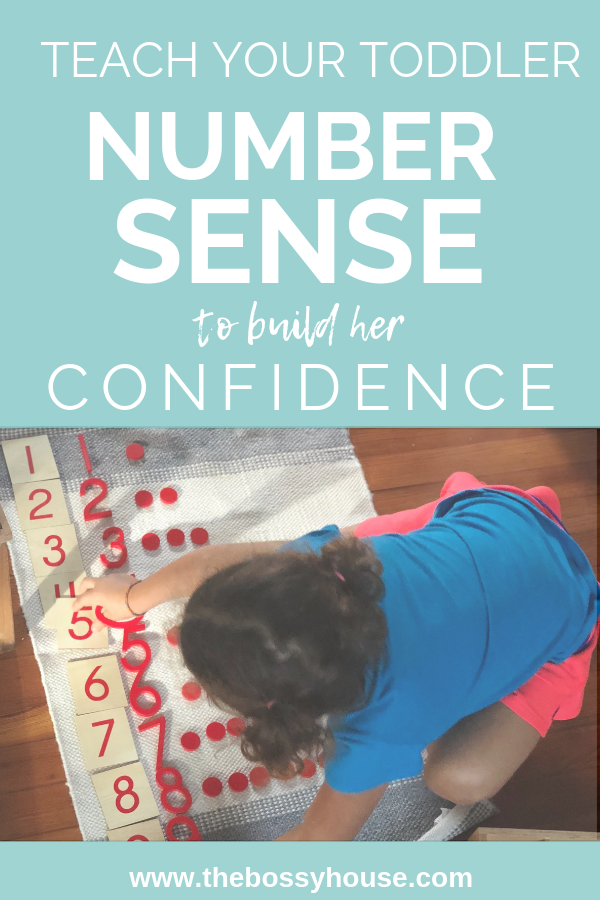THIS POST CONTAINS AFFILIATE LINKS. MY DISCLOSURE POLICY GIVES YOU MORE DETAILS.
Want to give your child a healthy dose of math confidence before Kindergarten? In preschool or at home, children should develop a sense of what numbers mean and how they work in order to be prepared to learn the more complex math that will be taught in Kindergarten. We are inspired by the Montessori method because it introduces work on number sense very early and incorporates physical objects to support your child’s learning.
4 Number Sense Concepts Your Child Can Learn Before Pre-K
- Quantification: understanding that all numbers are associated with a quantity of things and recognizing sets of items
- Counting: being able to match each set of items to a numeral
- Number Identification: being able to match the numeral with a quantity (know that four, 4, and **** are all the same idea)
- Addition and Subtraction: adding and taking away items from a set, which changes the numeral and the quantity
That’s pretty abstract. Suffice it to say, you want to be able to practice these four things before Kindergarten so your child has a sense of how numbers work. If you’ve never thought of these four things as being separate before, welcome to the wonderful world of toddlerhood!
Has your child ever made these math mistakes:
• been unable to tell you which pile of buttons was bigger or smaller? Or she needs to physically count every item, even if there are only one or two items in the pile? They are working on the concept of quantification, which means they can’t visually discriminate sets of objects yet.
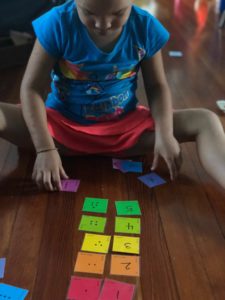
• “counted” a series of items but counted several of them twice? They are working on a sense of one-to-one correspondence, which is basically counting.
• struggled to keep track of the number name of a set of items he just counted? Or written the number 5 when she counted 8 items? She’s working on number identification.
• thought that “adding one” meant the pile still had the same amount? Or thought the pile now could be ANY possible new number? She’s working on addition.
All of these misunderstandings are completely common in toddlerhood. Your child is going through the process of figuring out how our number system works. Having a very solid foundation in each of these four skills before Kindergarten insures that the complex work of solving problems in Kindergarten will not be reduced to just an abstract process disconnected from the number system and the meaning of numbers.
Pin this info now to your Preschool Activities board!
Make a Math Game With Paint Chips
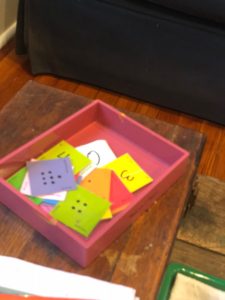
Games that help your child visually discriminate between sets of numbers will help them develop quantification. Even better if they then can label that set with a numeral (if you’re not a math geek: the “number” is the abstract idea of the quantity, and the numeral is the name for that thing.) Labeling a set with a number is the skill of number identification, and this game below helps with both skills.
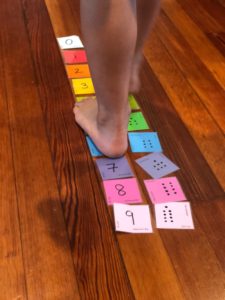
To make the game, I simply found identical pairs of paint chips, wrote a numeral on one and a corresponding set of dots on the other, and laminated them. Bonus points, I put them in rainbow order, as you do. I made this for the Girl when she was 18 months, and it has lasted us several years as she’s grown in her sense of numbers. At our house, we call all of our games “works” because we’re a Montessori family, just FYI.
At first, she matched the colors together, which was terrific. Then, we played around counting the dots on the chips. Then, when she was about 3 she naturally started matching the numeral with the number of dots. She still likes to line up the chips and still asks for this work to come out, though I do have to encourage her to put the paint chip pairs in order from least to greatest. And after she’s done, she loves to walk along the “number line” she’s made. (I have a kernel of an idea to make these bigger and use them for hopscotch, but I’ll let you know when that new math work materializes.)
Here are the things we used to make the Math Paint Chip game:
Use Montessori Materials to Reinforce Number Sense
To work on counting and adding, we use the Montessori Cards and Counters materials. These include tenwooden cards 1-10, ten cut-out numerals 1-10, and 55 red counter dots.
To start, have your child lay out the number cards either horizontally or vertically. Today, the Girl laid them out vertically because she’s four and wants to be the master of her own domain, so I didn’t argue. But sometimes we try to follow this Montessori procedure, which lays them out horizontally to start working on even and odd numbers. But not today. 🙂
Then, the Girl matched the cut-out number to the number card. This is because, in the early days of using this material, we would always start by matching since visual discrimination was what we were working on at age 2. Now, she does this out of habit, though you could leave this step out if you believe your child has mastered this.
Now for the most important part, the counters! The Girl puts a counter next to each numeral, matching the numeral and the amount it represents. This may seem like an “easy” exercise to us since we have mastered number sense, but this activity took the Girl 30 minutes. She counted and re-counted, placed the wrong number of counters several times and checked her work. I encouraged her to space out the counters so they were right under the previous row. This way, she can visually see that each numeral represents ONE MORE than the previous one. This is the skill she’s working on now, which is addition. To find out if your toddler is ready to work on this skill, note how labor-intensive adding counters to row five is. If they are counting each counter out separately and don’t just place down four and add one, they are working on addition!
Develop Her Confidence: Don’t Drill and Kill at Home
The biggest advice I have after watching loads of parents work with their child on number sense, is don’t fuss about it and don’t over-correct. These skills seem SO obvious to us. That’s because we are no longer toddlers. My daughter has been working on number sense for years, and when I say “working on it” I mean counting from 1-20 and leaving out the numbers 3, 8, 14, and 18. I mean counting everything six different times and coming up with a completely random or made up number. I mean lining four things up and indignantly saying “no mommy this is not four this is seven.” My advice to parents is to let it all go. Let them actually WORK with these numbers, meaning experiment, get it wrong, play around materials with no goal, try to emulate you, make up numbers that don’t exist, and use the materials to make stacks and rows and hopscotch.
Tips for Instilling Confidence
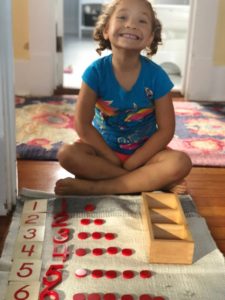
• Let it all go. Challenge yourself to watch her count something wrong and just sit there looking on.
• From time to time offer up a gem of wisdom, like “Oh how wonderful you put four of those in a row.” If she argues with you, shrug it off.
• There will be a time when she looks at you and asks “how many is this?” and you will answer with the correct answer. She knows you have the right answers, and she’ll consult you when she is ready to verify her own thinking with the correct answer.
Really, give yourself a break from being the arbiter of truth and let her get it wrong a lot. That is the work of learning right now, and if you come on pretty strong and correct her work all the time, she will come to see the work of learning as always needing to get the right answer. This shuts down her exploration and her confidence. It also invites a lot of resistance, and we all know what it’s like when our toddler simply won’t listen. For now, let your child explore and be ready with answers when she wants them.
Happy counting!


